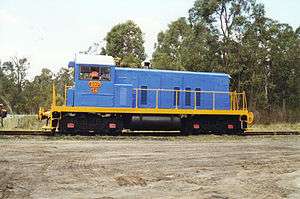BHP Newcastle 32 class
The BHP Newcastle 32 class were a class of diesel locomotives built by A Goninan & Co, Broadmeadow for the BHP, Newcastle steelworks between 1954 and 1956.
| BHP Newcastle 32 class | |||||||||||||||||||||||||||||||||||||||||||||||||
|---|---|---|---|---|---|---|---|---|---|---|---|---|---|---|---|---|---|---|---|---|---|---|---|---|---|---|---|---|---|---|---|---|---|---|---|---|---|---|---|---|---|---|---|---|---|---|---|---|---|
 34 at Richmond Vale Railway Museum in September 2000 | |||||||||||||||||||||||||||||||||||||||||||||||||
| |||||||||||||||||||||||||||||||||||||||||||||||||
| |||||||||||||||||||||||||||||||||||||||||||||||||
| |||||||||||||||||||||||||||||||||||||||||||||||||
| |||||||||||||||||||||||||||||||||||||||||||||||||
History
In 1954 BHP took delivery of three GE 70-ton switchers for use on its Newcastle steelworks network from A Goninan & Co, Broadmeadow with a further two delivered in 1956.[1]
There were several modifications form the standard US design. One is the alteration to the bogie pivot pin from the usual centre position to a point 18 inches (457 mm) towards the buffer beam. The alteration enabled the locos to travel the tight curves found in the works, and also reduced excessive buffer and coupler misalignment. Deep buffer beams were fitted with a 3 1⁄2-inch (89 mm) rail clearance, to minimise damage during derailments. To reduce excessive body roll due to poor track conditions, extra bearing pads were fitted to the outside of the bogie frame and the main frame. The fitting of large 64 cubic feet (1.8 m3) capacity air reservoirs on each side enabled the locos to be used with 6 of the pneumatic dump cars in use at the steelworks. Also as the standard US design did not have buffers fitted, the BHP locos were fitted with buffers with oversized buffer heads, necessary for the tight curves and BHP’s own internal rolling stock.
Class list
| Locomotive | Builder's No | Entered service | Withdrawn | Notes |
|---|---|---|---|---|
| 32 | 1/S0001 | Jul 1954 | Aug 1986 | preserved on static display at the Richmond Vale Railway Museum |
| 33 | 2/S0002 | Aug 1954 | Feb 1987 | - |
| 34 | 3/S0003 | Dec 1954 | Jan 1990 | stored at the Richmond Vale Railway Museum |
| 35 | 10/S3006 | Dec 1956 | Aug 1988 | - |
| 36 | 11/S3007 | Dec 1956 | Jun 1985 | - |
References
- Oberg, Leon (1984). Locomotives of Australia 1850s - 1980s. Frenchs Forest: Reed Books. p. 218. ISBN 0 730100 05 7.
- Men, Steel and Rails by David Jehan 1999, Published by BHP ISBN 1-876634-09-X
- Australian Diesel Scene 5 2002, Published by Eveleigh Press ISBN 1-876568-23-2
- Specification sheet ex BHP Newcastle Steelworks diesel shop
- Steel and Rails in Newcastle, by Keith McDonald 1981, Published by Light Railway Research Society of Australia ISBN 0-909340-15-3